Inspiration makes its way to us in the strangest of ways from time to time, doesn’t it?
A couple of weeks ago, I was scheduled to teach a pie crust class at Whole Foods in Cranston, Rhode Island. The plan was that I would demonstrate the method for making basic pie dough, and would bring along two herb-cheese doughs in varying states of doneness – raw and blind baked – as well as a peach crostata to give an example of sweet dough.
However, plans being what they are, and some of the better ones being laid to waste, as we’ve heard the cliche being dragged out of the mausoleum so many times before (yep, and me dragging its tattered corpse out now, too), a soaking rainstorm rolled into town, attendance at the pie crust class looked dismal, and we decided to cancel.
Cancel yes, but there I was with a peach crostata in the oven, and a double batch of herb-cheese crust awaiting some pie pan forming and blind-baking. Heck, the pie pan had even been buttered and was sitting atop the stove awaiting use. And the rain was wearing my motivation down. Less and less desirable seemed the prospect of blind baking.
Now, I know that I could have just frozen the dough, but my thinking was impaired by the sudden change in plans and the nasty rain. Plus, I had crostata on the brain, what with a peach one in the oven, as I pondered my next move.
“I should really start making savory crostatas sometime (crostate? is that the more correct Italian?),” I thought to myself. Yes, complete with the second-guessing of crostata/crostate, and the inclusion of the undefined “sometime”, as though I didn’t have savory dough at the ready right that minute or something.
If you aren’t familiar, a crostata is a free-form – let’s call it rustic, shall we? – tart that doesn’t require blind baking (clearly I was quite hung up on the “extra” step of blind baking).
Making a crostata would save me from having to refrigerate the dough in the pie pan for a half-hour once it was formed (this prevents the dough from shrinking while baking), and from having to line the dough with parchment paper and weighing the parchment paper down with my collection of dried Romano beans and pre-baking (aka “blind baking”) before filling it with something other than dried beans so that the dough will hold its shape once filled.
It took a moment, for my mind was dull. Or perhaps it was more like a few minutes. But then I saw the eggplant on the counter, and the tomatoes in the window. And realized that I had olives in the refrigerator, as well as feta. “Yesssss….I should make a savory crostata!” I actually said that out loud. To no one. Which happens rather frequently, I have to admit, though it’s not nearly as embarrassing when it happens in my kitchen as it is when it happens in public (let’s have your imagination cut to me in a store, laughing maniacally, or pouting and frowning as I mutter to myself, shall we? It ain’t pretty, I’ll tell ya.)
I am so glad that class was cancelled (well, really, I’m not, I was looking forward to getting flour all over myself in public while simultaneously preaching the ease of pie dough making), because this might be the best thing I’ve made all summer. Of course, if you don’t like eggplant, you won’t agree, so please don’t go trying this, Ms. Eggplant Hater, and then come back upset because this is most definitely not the best thing you’ve had all summer. This is for eggplant lovers only.
Now, with that said, you could make this with tomatoes and top with fresh mozzarella and basil and none would be the wiser. I have a feeling that this herb-cheese dough is going to get a lot of use here for the foreseeable future. I’m already plotting the potato and leek crostata which will be made the minute we harvest our potatoes and leeks (I’m guessing late September for that combo – I’ll keep you posted). Maybe there’s a kale crostata in our future as well. Or roasted broccoli. Or winter squash. Oh, savory crostata, how do I love thee? I think you can see that there will be many, many ways.
Ingredients
- 1 1/2 cups unbleached all-purpose flour
- 2 tablespoons grated Pecorino-Romano cheese
- 2 tablespoons finely chopped fresh herbs of your choosing (I used a combination of oregano, parsley, and thyme)
- 1/2 teaspoon baking powder
- 1/2 teaspoon kosher salt
- 1/2 teaspoon freshly ground black pepper
- 4 tablespoons vegetable shortening
- 4 tablespoons very cold unsalted butter, cut into pea-sized cubes
- 1/3 to 1/2 cup very cold water
- 1 tablespoon extra virgin olive oil
- 1 tablespoon Pecorino-Romano cheese (you won't need these last two until the very end - they coat the crust just before the crostata goes into the oven)
- 1 medium eggplant (approximately 1 pound)
- 1/2 tablespoon extra virgin olive oil
- kosher salt
- freshly ground black pepper
- 1 medium tomato (approximately 1/2 pound), chopped into 1/2-inch pieces and seeded
- 12 pitted kalamata or kalamata-style olives, halved
- 1/4 cup crumbled feta cheese
Instructions
- In a large bowl, mix the flour, cheese, herbs, baking powder, salt, and pepper.
- To the flour mixture, add the vegetable shortening and butter.
- I cheat - or at least I call it cheating, when, in fact, I'm starting to think that it's really just a handy trick to keep the butter from melting while making crust - by cutting the very cold butter into pea-sized cubes.
- Once upon a time, when I was very nervous about making pie crust, I took a class on pie crust at a restaurant in nearby Providence, Rhode Island. We students were instructed to use our fingers to break up the butter into pea-sized pieces, but to be careful that the pea-sized pieces not melt or be fully incorporated into the flour while mixing.
- You want the dry flour mixture to look as though it has pebbles (um, or peas) in it before you add the water, which is key to making a flaky crust, as solid fats are what enable crust, biscuits, and scones to have flakiness. As the pea-sized fats melt when the crust is baking, they create pockets of steam amongst the flour-water mixture, which, in turn, creates flakiness. This is the reason why we're so often cautioned not to overwork the pie dough - the goal is to not blend the butter and shortening completely into the flour, lest there be no flake. Those fats have to have some substance to them when the pie/crostata/tart enters the oven.
- After many years of running my fingers under cold water before working fats into flour, I finally realized that it would be just as easy, and quite likely result in more consistent flaky results, if I cubed the butter into those pea-sized pieces before adding it to the flour. If you're using stick vegetable shortening (rather than the type in a canister), feel free to cube that up pea-style as well.
- Working quickly, and with the tips of your fingers to avoid melting the fats (there is still a risk, oh ye of the 98.6 degree hands) evenly distribute the butter and shortening throughout the flour concoction.
- Grab a fork to use for the final mixing of water into flour, and pour 1/3 cup of the cold water over the flour mixture, ideally dousing all areas of your bowl.
- Gently mix the water into the flour mixture. The resulting dough will look a bit ragged - not to worry. If dry ingredients remain after the initial wetting, gradually pour the remaining water onto the dry flour, then mix that into the shaggy-looking dough.
- Turn the dough out onto a piece of plastic wrap or waxed paper, gently press it down so that it resembles a very thick pie crust rather than a ball (I find that this flattening makes it easier to roll out the dough when the time comes), then seal the dough up with the wrap/paper, and place it in the refrigerator for 1/2 hour (and up to 24 hours if you'd like to do this bit of labor ahead of time).
- Oil your grill grate if necessary. Preheat your grill to high.
- Slice off the very top of the eggplant (the green thorny stem-side), then cut the eggplant lengthwise down the middle. Drizzle the olive oil over both sides, then season with salt and pepper.
- Once the grill is preheated, place the eggplant cut-side down on the grill, cover, and cook for 3 to 4 minutes, or until the flesh is beginning to soften on the cut side, and grill marks are clearly visible. Flip the eggplant over so that the skin side is facing the flame, cover, and grill for an additional 3 to 4 minutes until the skin is slightly charred and the entire eggplant is soft.
- Remove the eggplant from the grill, and allow it to cool for 20 minutes before cutting it into 1/2-inch wedges. If the eggplant's skin is thicker than you like, or if you have an aversion to eggplant skin, feel free to peel it off once it's cooled.
- Just before you're about to roll out the dough, preheat the oven to 400 degrees Fahrenheit. Have a 10 by 15-inch rimmed baking sheet that has been lightly dusted with flour or finely ground cornmeal at the ready.
- Roll the dough out with a lightly floured rolling pin on a lightly floured surface until it is a misshapen rectangle of approximately 10 inches by 15 inches.
- In another cheating move, I normally do this rolling out on a piece of lightly floured reusable parchment paper (regular parchment paper will do quite nicely as well) which I then slide over the edge of my baking sheet. This eliminates the need to flour the baking sheet, makes the dough transfer easier, and allows me to bake the crostata directly on the parchment.
- If you are not using the parchment paper trick, carefully move the misshapen rectangle of dough from your work surface to the rimmed baking sheet.
- Place the eggplant atop the crust so that it covers all but a 2-inch border of crust all around the edge. Top the eggplant with the chopped tomato, then place the olive halves intermittently around the eggplant-tomato filling.
- Next, sprinkle the feta cheese over top of the whole lot, then fold the two long edges of the crust up over the filling, followed by the two short edges. Finally, tuck the corners up over themselves and press them into the dough to seal the seams.
- For a crisp, golden brown, cheesy crust, carefully brush the crust with one tablespoon of olive oil, then sprinkle 1 tablespoon of grated Pecorino-Romano cheese over top, and place the crostata in the oven.
- Bake the crostata for 40 minutes, or until the crust is golden brown. To avoid having a self-destructing eggplant-volcano of a crostata, allow the crostata to cool for at least 20 minutes before cutting into it.
Estimated cost for one eggplant crostata: $7.83. The flour costs approximately 36-cents for 1 1/2 cups. The total of Pecorino-Romano cheese for the entire dish costs around 18-cents. The baking powder costs less than 1-cent, but we’ll round up and throw the penny in. The herbs can be nearly free if you grow them, or we can call it 50-cents for purchased herbs. The vegetable shortening costs 45-cents, the butter costs 35-cents. The total olive oil for the crust and eggplant grilling costs 24-cents. The eggplant costs $1.99 per pound, and tomatoes have come down in price in my area this summer (thanks to the lack of late blight destruction) to $2.95 per pound for field-grown (down from $3.25/pound), so 1/2 pound would be around $1.50. The olives cost $4.99 per pound, our 12 olives are a little less than 1/4 pound, so that’s $1.25. The feta cheese costs $2.99 for 6 ounces, we used about 2 ounces, and that costs us $1.00. A hearty 8 servings per crostata costs us 98-cents per serving.
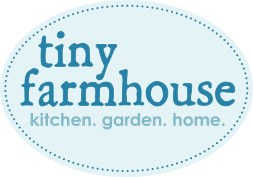
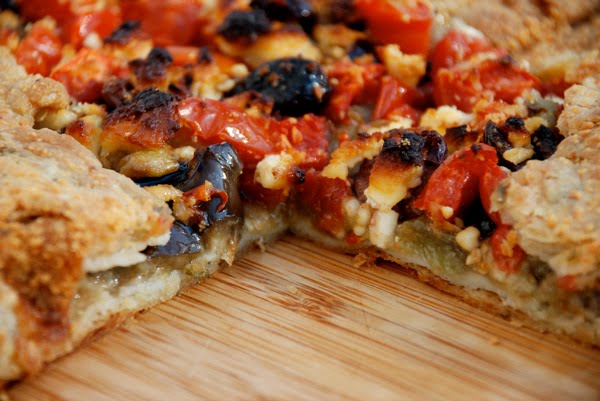
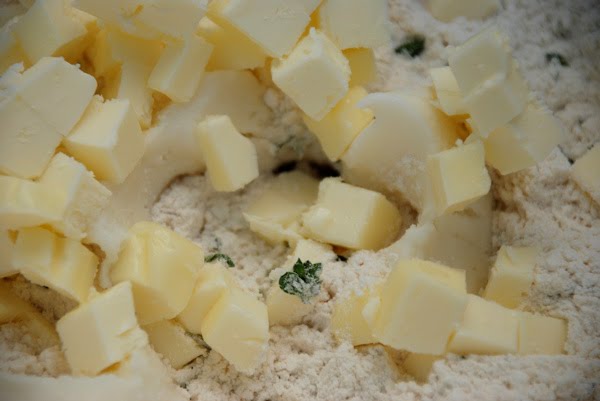
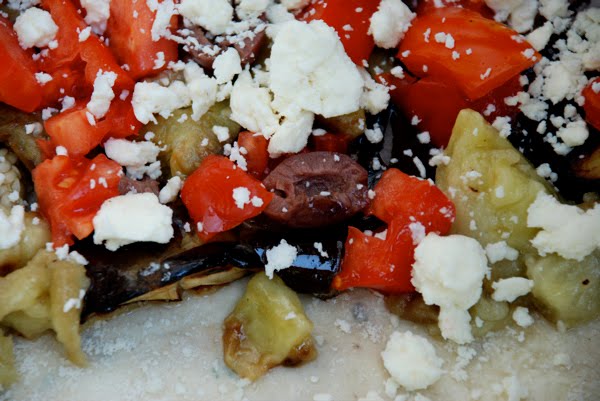
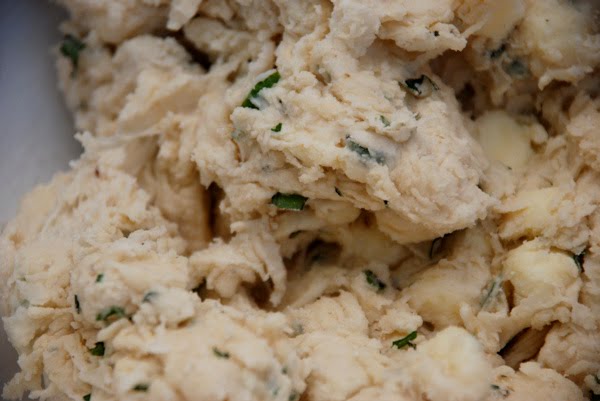
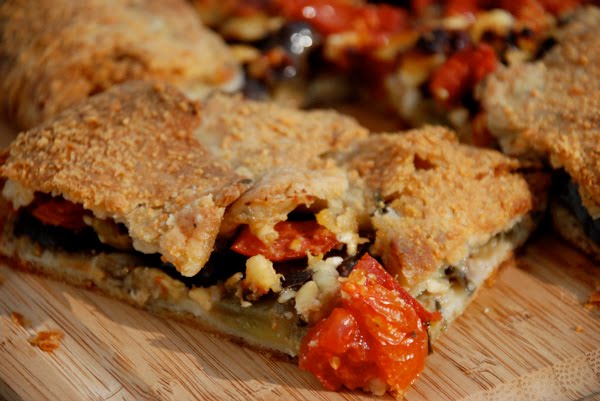

This looks amazing! I’m hungry just thinking about it.
This looks and sounds amazing, another one to add to the must try list!!!
This looks so good! I love crostadas and this one sounds fabulous-thanks!
I love the herb crust idea! How versatile. Looks amazing, I’ll have to give that a go.
That looks great, thanks for sharing!
ok, what is the difference between a crostata and a galette? cus i made a galette last night & it’s eerily similiar to your crostata, only it was filled with apples. is one savory and the other sweet? (i feel like may have just answered my own question or revealed how incredibly un-cool i am…)
j’adore this dish, eggplant is ok but i think the versatility of what you can put in your crostata makes it so appealing to me.
Thank you, Elizabeth!
Luigi, coming from you, that means a lot!
Abbey, thank you so much!
SBK, it really is versatile, and can be made ahead and frozen for, um, dough emergencies!
Thank you, Kristy!
Hi Lan! One difference is which side of the French/Italian culinary terminology border you choose to hang around on. And, also, how many liberties you take with using the term “crostata” (not that anyone we know would do such a thing, right?). The French seem to embrace all fillings, savory or sweet, in their galette, while my understanding is that a crostata is generally considered a sweet item filled with jam or fresh fruit in Italy. I’ll see if I can find more clarification on that – maybe this savory crostata isn’t an anomaly, even in Italy!
What a cool recipe–not something I’ve made before. I’m saving it to my “recipes to try” folder.
That is making me uber hungry. Wonderful blog!
My dear, that sounds (and looks!) like the best rainy day ever. See you tomorrow! xo
I made this and it really is fantastic!
This looks amazing! Can’t wait to try it!